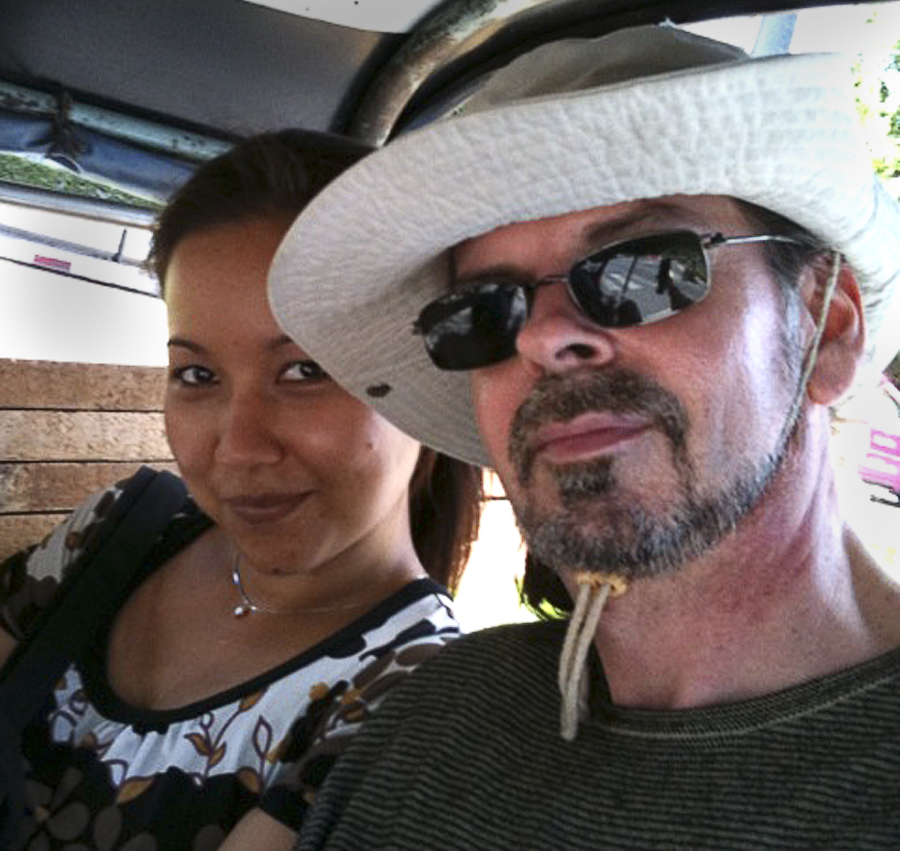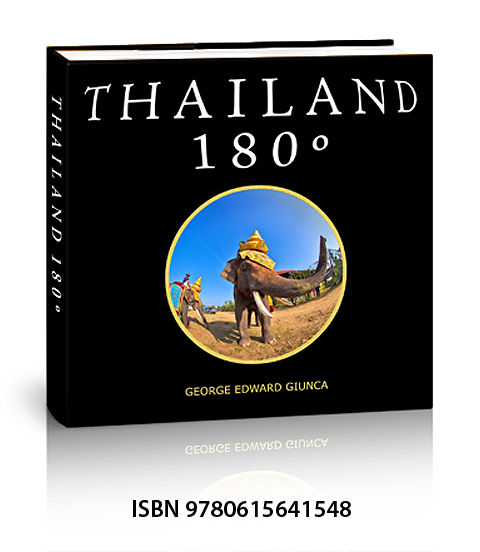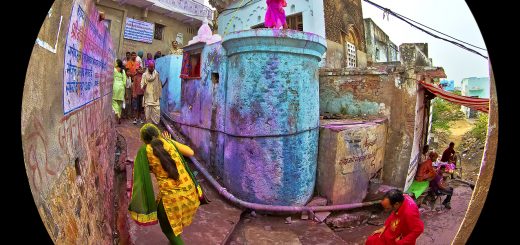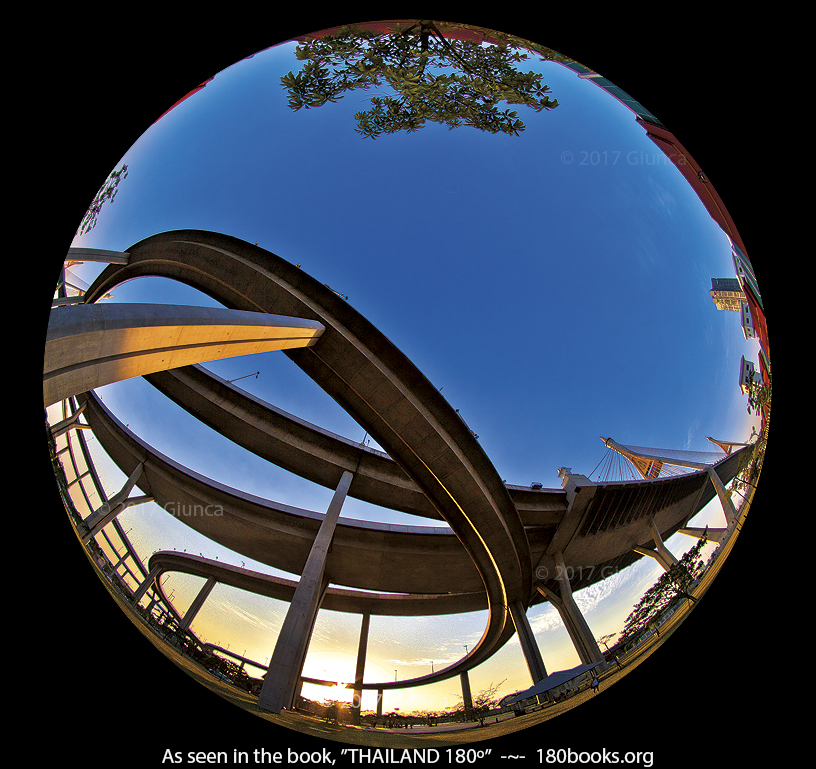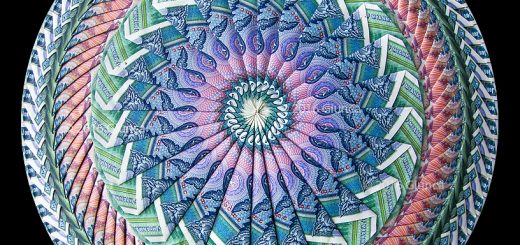8 Must See Temples in Bangkok, Thailand Part 2 ~ 8 วัดทรงคุณค่า แห่งมหานครกรุงเทพ
Continued…
If you missed part one of our blog, 8 Must-See Temples in Bangkok, Thailand ~ part 1, just click and you can go to read about it now. Otherwise, head towards the Democracy Monument and join us for the second part of our tour.
ความเดิมตอนที่แล้ว…
บล็อก THAILAND 180º นำเสนอ “8 วัดทรงคุณค่า แห่งมหานครกรุงเทพ” ที่นักท่องเที่ยวต้องไปยลความงดงามอลังการ ความมีคุณค่าทางศิลปกรรมและสถาปัตยกรรมที่ละเอียดอ่อน ตั้งแต่พื้นหินอ่อนจรดดาวเพดาน … คราวนี้มาชมกันต่ออีกสี่วัดสุดท้ายค่ะ
5. The Golden Mountain & Wat Saket ~ ภูเขาทอง และ วัดสระเกศ

Golden Mountain at Wat Saket (George Edward Giunca/Image from the 180books.org Photo Collection by George Edward Giunca)
From the democracy monument, look to the east, and you will see the Golden Mountain on your right, which is situated in the Wat Saket compound. The Golden Mountain was built during the reign of King Rama III. It was difficult to build and couldn’t be completed during his reign. Construction was restarted by King Rama IV, and the name was changed to Borom Banpot, and a golden chedi was built on top, with a winding stairway was leading to it. This was finally finished during the reign of King Rama V. A holy relic of Buddha was then installed which had been brought from Kapilavastu, Nepal. The Golden Mountain is 63.6 meters high and is reached by climbing 344 steps. From the top, you can see a great view of Bangkok. It may sound like a lot of steps but the ascent goes quickly.
จากอนุสาวรีย์ประชาธิปไตยมุ่งไปทางทิศตะวันออก เยื้องไปทางขวา จะเห็น “ภูเขาทอง” ที่ตั้งอยู่บริเวณวัดสระเกศ ภูเขาทองเริ่มสร้างขึ้นในสมัยรัชกาลที่ ๓ เช่นกัน เพื่อเป็นปูชนียสถานในพระนครเช่นเดียวกับกรุงศรีอยุธยาที่มีวัดภูเขาทอง อยู่ตรงจุดบรรจบระหว่างคลองบางลำพูกับคลองมหานาค แต่ประสบปัญหาในการก่อสร้างจึงต้องยุติชั่วคราว และเริ่มการสร้างใหม่อีกครั้งในสมัยพระบาทสมเด็จพระจอมเกล้าเจ้าอยู่หัว และเปลี่ยนชื่อเป็น “บรมบรรพต” โดยมีลักษณะเป็นภูเขาที่มีเจดีย์ตั้งอยู่ด้านบน มีบันไดเวียนขึ้น-ลงสองทาง การก่อสร้างแล้วเสร็จในรัชสมัยพระบาทสมเด็จพระจุลจอมเกล้าเจ้าอยู่หัว และบรรจุพระบรมสารีริกธาตุจากเมืองกบิลพัศดุ์ใว้ในองค์พระเจดีย์ เจดีย์ภูเขาทองปัจจุบันมีขนาดสูงจากฐานถึงยอด 63.6 เมตร มีบันไดทอดขึ้นเป็นบันไดเวียน 344 ขั้น เมื่อเดินถึงลานพระเจดีย์ด้านบนสามารถมองทัศนียภาพกรุงเทพมหานครได้รอบ

Morning prayer session at Wat Saket (Image from the 180books.org Photo Collection by George Edward Giunca)
6. Wat Ratchanadda ~ วัดราชนัดดารามวรวิหาร

The Loha Prasat of Wat Ratchanaddaram Worawihan (Image from the 180books.org Photo Collection by George Edward Giunca)
The Loha Prasat of Wat Ratchanaddaram Worawihan was built during the reign of King Rama 3 and has been a beautiful part of Rattanakosin for over 170 years. The original plan was for it to be a square design based on the Loha Prasat in Sri Lanka, and the Thai architects reinterpreted the design from there. The Prasat is seven stories tall with a spiral stairway with 67 steps. Thirty-seven spires surround the Prasat. The building was only partially completed at the time of the passing of King Rama III, and many restorations took place during the succeeding years. A major restoration was carried out later in 1963 in accordance with the original plans of King Rama III.
In 1996 the roof was changed, and all the spires were replaced by metal with a black finish which is appropriate as the name “Loha” means metal in Thai. In 2012 yet another renovation improved the landscape to better show the Prasat as the Gateway to Rattanakosin Island, the policy of Crown Property Bureau. Recently gold was added to the spires.
ข้ามถนนจากวัดสระเกศมา วัดราชนัดดา “โลหะปราสาท” ตั้งตระหง่านคู่กรุงรัตนโกสินทร์มากว่า 170 ปี สร้างในสมัยรัชกาลที่ ๓ โดยมีแผนผังรูปสี่เหลี่ยมจตุรัสตามต้นแบบโลหะปราสาทที่ศรีลังกา และดัดแปลงให้มีลักษณะทางพุทธศิลป์และสถาปัตยกรรมไทย เป็นอาคาร 7 ชั้น ลดลั่นกัน มีบันไดวนตั้งอยู่ตรงใจกลางของอาคาร อาคารชั้นล่าง ชั้นที่ 3 และชั้นที่ 5 เป็นคูหาและระเบียงรอบ ส่วนชั้นที่ 2 ชั้นที่ 4 และชั้นที่ 6 ทำเป็นคูหาจตุรมุขมียอดเป็นบุษบกชั้นละ 12 ยอด และ ชั้นที่ 7 เป็นยอดปราสาทจตุรมุขสำหรับประดิษฐานพระบรมสารีริกธาตุ รวมเป็น 37 ยอด มีความหมายถึงโพธิปักขิยธรรม 37 ประการ อันเป็นหลักธรรมคำสอนทางพระพุทธศาสนาซึ่งเป็นหนทางสู่พระนิพพาน
เมื่อพ.ศ. 2539 มีการบูรณปฏิสังขรณ์โลหะปราสาท เปลี่ยนวัสดุมุงและเครื่องประดับหลังคาเป็นโลหะและทองแดงรมดำ …อย่างที่เห็นในภาพของ THAILAND 180º
ในปี พ.ศ. 2555 ดำเนินการบูรณะปฏิสังขรณ์และปรับปรุงภูมิทัศน์ของวัดครั้งสำคัญและใส่ใจทุกรายละเอียดตามหลักการอนุรักษ์โบราณสถานให้มีความงดงาม เพื่อเป็นสมบัติของชาติสืบไป อันสอดคล้องกับนโยบายของสำนักงานทรัพย์สินส่วนพระมหากษัตริย์ที่จะพัฒนาพื้นที่บนถนนราชดำเนินเป็นพื้นที่ท่องเที่ยวเชิงอนุรักษ์และเปี่ยมด้วยคุณค่าทางประวัติศาสตร์ ปัจจุบันได้ทำการปิดทองคำเปลวบนยอดโลหะปราสาทแล้ว
(อ้างอิง: ราชนัดดามหาเจษฎานุสรณ์. 2555. สำนักงานทรัพย์สินส่วนพระมหากษัตริย์. http://www.crownproperty.or.th/public/upload/media/Recommended%20Books/3b37c3b2a1b84085a49bd0713cded753.pdf)
7. Wat Benchamabophit วัดเบญจมบพิตรดุสิตวนาราม

Wat Benchamabophit or the Marble Temple (rear) (Image from the 180books.org Photo Collection by George Edward Giunca
No one knows for sure when the construction this temple began. During the reign of King Rama III, the compound of this temple was used by a prince as an army base to protect the city from various rebel factions. After the threat had passed, the prince along with his brothers and sisters donated money to renovate the building as a temple and constructed five chedis in front of the temple. It was then named Wat Benchabophit meaning the temple of the five royal family members. Later, as King Rama V developed the surrounding land as Dusit Park, he reestablished Wat Benchabophit as a royal temple, renaming it Wat Benchamabophit, which means The Temple of King Rama V. He requested that upon passing his ashes be interred under the main Buddha image, Phra Buddha Chinnarat. The temple is also known as The Marble Temple owing to its construction from Carrera Marble that was imported from Italy. An image of this temple is on the reverse side of the 5 Baht coin.

Phra Buddha Chinnarat in the Marble Temple (Image from the 180books.org Photo Collection by George Edward Giunca)
วัดเบญจมบพิตร เดิมเป็นวัดโบราณ ชื่อว่า “วัดแหลม” หรือ “วัดไทรทอง” ไม่ปรากฏว่าสร้างเมื่อใด … ครั้นรัชสมัยพระบาทสมเด็จพระนั่งเกล้าเจ้าอยู่หัว กรมพระพิพิธโภคภูเบนทร์ พระราชโอรสในรัชกาลที่ ๒ โปรดตั้งกองทัพรับปราบขบถเจ้าอนุวงศ์ที่วัดนี้ หลังเสร็จจากการรบแล้วจึงปฏิสังขรณ์ โดยร่วมกับพระเจ้าน้องยาเธอ อีก 4 พระองค์ คือ กรมพระพิทักษ์เทเวศร์, กรมหลวงภูวเนตรนรินทรฤทธิ์, พระองค์เจ้าหญิงอินทนิล, และพระองค์เจ้าหญิงวงศ์ พร้อมทั้งสร้างพระเจดีย์ไว้เป็นอนุสรณ์ 5 องค์ เรียงอยู่ด้านหน้าวัด … ต่อมาสมัยรัชกาลที่ ๔ โปรดเกล้าฯ พระราชทานนามวัดใหม่ว่า “วัดเบญจบพิตร” หมายถึง วัดของเจ้านาย 5 องค์
ครั้นถึงรัชสมัยรัชกาลที่ ๕ มีพระราชประสงค์จะทรงสร้างพระราชอุทยาน “สวนดุสิต” (พระราชวังดุสิต ในปัจจุบัน) จึงโปรดเกล้าฯ ให้จัดซื้อที่ดิน โดยมีวัด 2 แห่ง คือ วัดดุสิต และวัดเบญจบพิตร โดยสร้างเพียงวัดเดียว แต่ทำให้วิจิตรงดงาม และสมควรที่จะเป็นวัดอยู่ใกล้เขตพระราชฐาน จึงทรงทำ “ผาติกรรม” สถาปนาวัดเบญจบพิตรขึ้นใหม่ และถือว่าวัดแห่งนี้เป็นวัดใหม่ที่พระองค์ทรงสถาปนาขึ้น … โดยเมื่อสถาปนาขึ้นแล้ว ทรงพระราชทานนามใหม่ เติมอักษร “ม” เป็น “วัดเบญจมบพิตร” ซึ่งหมายถึง วัดของพระเจ้าแผ่นดินรัชกาลที่ ๕ และทรงแสดงพระราชประสงค์ไว้ว่า เมื่อพระองค์สวรรคตและถวายพระเพลิงพระบรมศพแล้ว ให้นำพระบรมราชสรีรางคาร (เถ้ากระดูก) ไปบรรจุไว้ใต้รัตนบัลลังก์พระพุทธชินราช … อีกหนึ่งปีถัดมาพระองค์ได้พระราชทานที่วัดเพิ่มเติมและโปรดให้เพิ่มสร้อยนามต่อท้ายว่า “ดุสิตวนาราม” เรียกรวมกันว่า “วัดเบญจมบพิตรดุสิตวนาราม”
8. Wat Tri Mitr ~ วัดไตรมิตรฯ
Don’t go back to your hotel yet! I want to tell you about a five and a half ton, solid gold Buddha image. Folklore tells us that three Chinese friends initiated the construction of this temple and it was named Wat Sam Chin, meaning Three Chinese Men. The photo above shows the interior of the famous pavilion that is constructed of marble and houses a 18K solid gold Buddha image, officially titled Phra Phuttha Maha Suwana Patimakon. At about 3 meters tall and weighing in at 5.5 tons, with an estimated value in 2013 of 250 Million USD, according to the Guinness Book of World Records. Previously, this Buddha image was hidden, encased in cement, until a crack in the cement revealed that there was a gold image inside. Interestingly, the cement covering was modeled in the same image as the golden image that it encased. As the cement was removed and the base of the statue was examined, it was learned that a special device enabled the image to be disassembled into nine pieces, allowing it to be moved and reassembled with ease.
มาถึงวัดสุดท้ายที่จะกล่าวถึงในบล็อกนี้ คือ วัดไตรมิตรวิทยารามวรวิหาร หรือ เรียกสั้นๆ ว่า วัดไตรมิตร … เป็นพระอารามหลวงชั้นโท ชนิดวรวิหาร สร้างสมัยใดไม่มีปรากฏหลักฐาน มีเพียงเรื่องเล่ากันว่าชาวจีน 3 คน เป็นมิตรที่สนิทสนมกันมาก ร่วมใจกันสร้าง จึงได้นามว่า “วัดสามจีน” … ต่อมาได้เปลี่ยนนามเป็น “วัดไตรมิตรวิทยาราม”
ภาพด้านบนที่นำมาให้ชม เป็นภายในพระมหามณฑปเฉลิมพระเกียรติ ๘๐ พรรษา สร้างจากหินอ่อนทรงไทยวิจิตรศิลป์ เป็นที่ประดิษฐานพระพุทธมหาสุวรรณปฎิมากร หรือ พระพุทธรูปทองคำ ซึ่งพระพุทธรูปองค์นี้เป็นทองคำบริสุทธิ์สมัยสุโขทัย ปางมารวิชัย น้ำหนักประมาณ 5.5 ตัน … แต่เดิมถูกพอกปิดด้วยปูนทั่วทั้งองค์ จนกระทั่งมีผู้พบรอยแตกที่พระอุระ และเห็นรักที่ฉาบผิวองค์พระด้านใน เมื่อแกะรักออก จึงพบว่าเป็นเนื้อทองคำบริสุทธิ์ อีกทั้งยังพบกุญแจกลสำหรับถอดองค์พระออกเป็น 9 ส่วน ซึ่งเอื้อต่อการอัญเชิญขึ้นประดิษฐานยังพระวิหาร
เคยมีการตรวจสอบและประเมินเนื้อทองขององค์พระพุทธรูปซึ่งเป็นทองคำบริสุทธิ์ เรียกว่า ทองเนื้อเจ็ด น้ำสองขา น้ำหนักกว่า 5 ตัน คิดเป็นน้ำหนักทองคำ 25,000 ปอนด์ …โดยหนังสือกินเนสบุ๊ค ฉบับปี ค.ศ. 1991 (พ.ศ. 2534) ได้ทำการประเมินค่าอย่างเป็นทางการและบันทึกไว้ว่า เป็นพระพุทธรูปทองคำขนาดใหญ่ที่สุดในโลก มีมูลค่าเฉพาะเนื้อทองคำสูงถึง 21.1 ล้านปอนด์ หรือ อีกแหล่งหนึ่งประเมินมูลค่าเป็นเงินกว่า 250 ล้านเหรียญสหรัฐ … ถ้าถามคนไทยที่เห็นคุณค่าในงานศิลป์อย่างดิฉัน ตอบเลยว่า พระพุทธรูปองค์นี้ไม่สามารถประเมินเป็นมูลค่าทางตัวเงินได้
อย่างที่ตั้งชื่อบล็อกไว้ล่ะค่ะ ว่าเป็น “8 วัดทรงคุณค่า แห่งมหานครกรุงเทพ” ที่ต้องไปยลความงดงามอลังการ ความมีคุณค่าทางศิลปกรรมและสถาปัตยกรรมที่ละเอียดอ่อน ตั้งแต่พื้นหินอ่อนจรดดาวเพดานกันเลยทีเดียว … จบบล็อกนี้แล้ว หาโอกาสไปสักการะและซึมซับความล้ำค่าแห่งมรดกศิลป์กันนะคะ
!!..คลิ๊กแผนที่..!! ดูภาพสวยๆ อ่านบล็อกสถานที่ท่องเที่ยวจาก THAILAND 180º ได้นะคะ อัพเดทเพิ่มเติมตลอดค่ะ
We had to eliminate the ability to comment from this wordpress site due to excessive spam. If you enjoyed this story, subscribe using the “Subscribe” button below, or visit our facebook fan page to comment Here
We’d LOVE to hear from you!
ผู้ติดตามอ่านบล็อก สามารถติดตามอัพเดทโพสต์บล็อกได้โดยสมัครสมาชิกที่บล็อกนี้ หรือ กดไลค์เฟสบุ๊คเพจของเราที่นี่ Here
Blog : Thai by Apisatha Hussadee Giunca
Blog : English by George Edward Giunca
About the Authors
Photographer George Edward Giunca, and his Thai wife, Apisatha, have traveled around Thailand armed with a circular fisheye lens to create a photo essay on the rich cultural diversity, and abundant natural beauty of the Kingdom of Thailand. Fleeing from angry water buffaloes, slapping huge mosquitoes, watching exotic festivals and religious rituals, gorging on delicious spicy food, applying aloe vera cream to sunburned skin, wading through rice paddies, getting drenched to the bone by heavy monsoon rains, and gawking at breath-taking scenery; made it a journey of epic proportions! The result is the book, THAILAND 180º. Later, they traveled extensively through Myanmar, Malaysia, and India, gathering a massive collection of 180º photos. They currently live in Chiang Mai where they continue to blog and are now working on a CHIANG MAI 180º book.
Here’s How to Order Your Copy of THAILAND 180º Collectors EditionToday!
In Thailand —>>>http://www.thailand180.com/thaiorder.html
The Rest of the world: We are offering our book on Amazon.com, below list price and I’ll pay for the shipping within the United States! http://amzn.to/1knDPRR
Not Familiar with Our Book???
This show details the origin of 180 Books, a series of art/travel books illustrated with a circular fisheye lens. By using infographics, pictures from our THAILAND 180º book, and never seen before images from our vault, we’ll demonstrate this unique lens and present our unique books.
Also, because there’s nothing to watch on TV, here’s a trailer about our book, “THAILAND 180”




